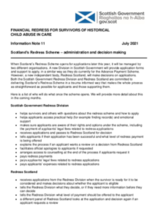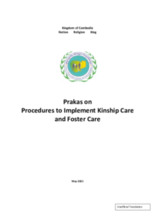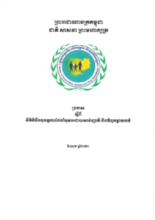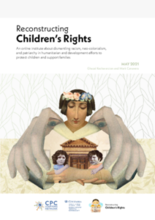Displaying 61 - 70 of 1727
A fost efectuată o evaluare cuprinzătoare a copiilor și adolescenților care trăiesc în îngrijire rezidențială identificând că există un mecanism complex de evaluare, axat pe oferirea unei vederi de 360° asupra nevoilor și interesului superior al copilului.
This study consists of an analysis of government digital policies focused on children in Uruguay between 2009 and 2019. To facilitate this, the CRC was used as a framework to categorise key features of the principal strategies that have been implemented. It argues that while great advances have been made in terms of digital access, this has not been sufficiently accompanied with comprehensive and child-centred solutions that encompass regulations and children and adult digital education.
Update on administration and decision making work taking place since the The Redress for Survivors (Historical Child Abuse in Care) (Scotland) Bill was passed by Parliament in March 2021.
This webinar, the fourth in a series from the Transforming Children's Care Global Collaborative Platform, explored the importance of protecting the child’s right to identity in how it is created, how it may be modified and/or falsified in alternative care as well as the need to preserve information about the child’s identity, notably family relations.
These presentations from UNICEF and Eurochild were delivered during the June 25 2021 workshop of the Care Measurement Task Force. The focus of the workshop was the development of the residential care toolkit (led by UNICEF) and care measurement in the EU region.
This Prakas was drafted in accordance with Cambodia’s policies, standards and regulations to enable the implementation of kinship care and foster care. The Goal of the Prakas is to ensure the best interests of the child and protect the basic rights of the child separated from his/her biological parents and receiving kinship or foster care, so that they are safe and thriving in a warm, loving and happy family environment.
The Goal of the Prakas is to ensure the best interests of the child and protect the basic rights of the child separated from his/her biological parents and receiving kinship or foster care, so that they are safe and thriving in a warm, loving and happy family environment.
The goal of the Reconstructing Children’s Rights Institute is to raise awareness and recognition of how racism, patriarchy, and power permeate the international child rights and child protection field. Building on Conversation #1, this session expands our political imagination by delving deeper into the international children’s rights and child protection space.
This paper, based on an extensive desk review, chronologically examines the evolution of aftercare laws and practices in India along with the factors that contributed to the rise of institutional care.
The Ngulluk Koolunga Ngulluk Koort (Our Children Our Heart) project conducted extensive Elder and community consultation to develop principles and practice recommendations for child protection governance in Western Australia. The authors of this paper explore these principles and practice recommendations and highlight the need for culturally safe community consultation and governance with a focus on repairing damage incurred by the Aboriginal and Torres Strait Islander community from past child protection policies.





